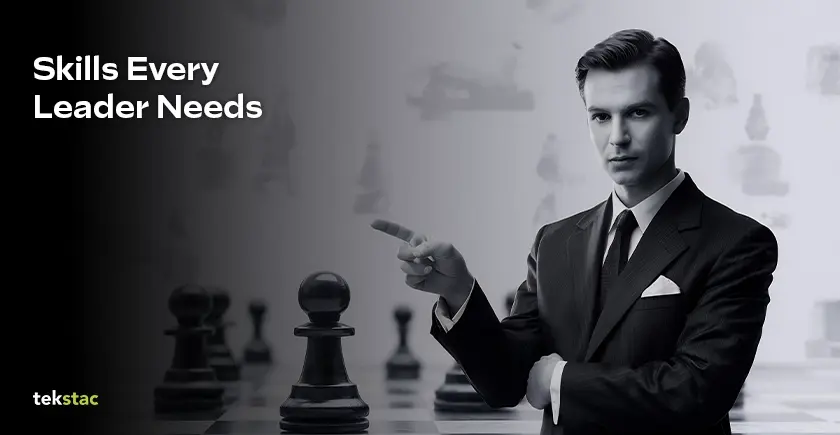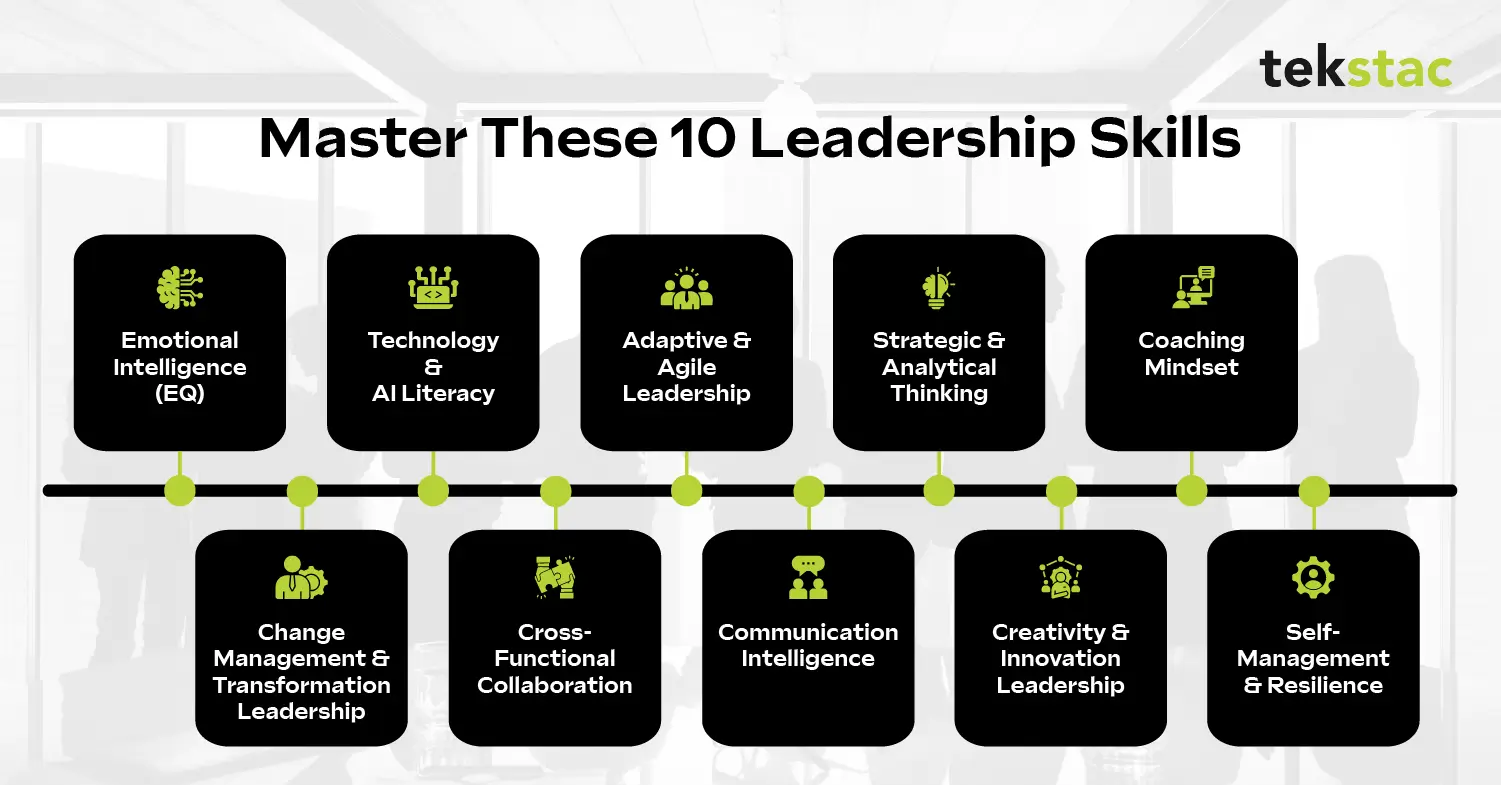10 Best Leadership Skills Every Professional Should Possess in 2025

Today, leadership is in crisis. Workers are losing faith in leaders because many just aren’t measuring up.
DDI Global Leadership Forecast 2025 states that the trust in management fell from 46% in 2022 to as low as 29% in 2024, an enormous plunge. It shows how much everybody distrusts their leaders now.
While so much of the world is changing at the speed of light due to technology and remote work, leaders are still blamed for lacking rudimentary human competencies such as empathy and clear communication, which are one of the best leadership skills.
If you examine legendary leaders throughout history, you will see that they possessed these competencies in abundance. Today, far too many leaders lack these competencies.
Then, what do today’s professionals need to learn to keep up with today’s requirements and thrive amidst all this change? This blog will discuss the 10 most critical leadership skills required in 2025 and how to develop them.
10 Best Leadership Skills Every Professional Needs In 2025
One must observe that some leadership qualities are never so old. Empathy, communication, and trust have been the pillars of good leadership and will forever be.
But the world keeps evolving at this fast pace, and with it, the kind of skills leaders need. For example, computer literacy was not as critical previously as it is today. Today, the skill of coping with AI and technology is what any leader needs. With new opportunities and challenges by 2025, leaders will have to change and evolve.

1. Emotional Intelligence (EQ)
What if it is possible to be a good leader through emotional understanding? Emotional Intelligence (EQ) has already passed from being a soft skill to being the basis of fearless leadership. EQ is about paying attention to your feelings and others’, managing your reactions, and establishing genuine relationships.
In the age of AI dominance, we cannot live without trust and empathy. EQ leaders create psychologically safe environments, with collaboration and innovation thriving even when teams are separated by geography across continents. For instance, the most incredible testimony to Satya Nadella’s Microsoft transformation is where he created the learning and empathy culture and re-stoked the growth and morale of the company.
How to build it: Practice vulnerability by opening up your problems. Always consider your emotions, and ask your colleagues for straightforward opinions to become sensitive to forming relationships. Practice empathy daily.
2. Technology & AI Literacy
Talent in 2025 will need to ride the wave of AI. 71% of CEOs in Korn Ferry’s 2025 Global Workforce Survey are confident that AI will add value to their worth within three years. Leaders today must have first-hand experience with AI and new technology. This skill enables them to identify improvements in efficiency, anticipate risk, shape responsible use of AI, and increase the agility and creativity of decision-making.
This leads to more effective decision-making and facilitated groups of de-drudged work. Amazon’s early implementation of AI to maximize logistics set industry standards and pushed hyper-growth revenue, demonstrating tech know-how pays.
How to build it: Get AI and digital literacy skills training, engage with tech forums, and collaborate with internal experts to stay competitive.
3. Adaptive & Agile Leadership
Most leaders are playing catch-up on talent as though it were 2010, and their leadership is outdated. John Maxwell’s book, Leadershift, is about leaders shifting their style so they can keep up with the pace of a changing world. Adaptive leaders create a culture where teams learn fast, turn fast, and embrace failure as a stepping stone.
For example, Netflix’s transition from DVD rentals to streaming is a quintessential example of agile leadership, making an early bet on video streaming revolutionized the company and kept it ahead of the curve.
How to build it: Condition yourself to be agile in mind by exposing yourself to something new and getting a great many different ideas every day.
4. Strategic and Analytical Thinking
Strategic thinking is seeing the big picture, connecting the dots, and making well-thought-out decisions driven by long-term organizational goals. This is reinforced by analytical thinking, which assists leaders in filtering information, identifying trends, and projecting possible risks or opportunities. With increasingly dynamic markets and data being the default norm, leaders possessing such skills create lasting competitive advantages.
As Jim Collins quotes in Good to Great, a strategic mind at the disciplined level is one of the characteristics of great companies that beat others in the long run. Leaders of 2025 must avoid the fix-it approach and define goals based on objective analysis instead. It causes the leaders to utilize resources cost-effectively, set priorities, and drive uncertainty within the team.
How: Work actively with information, encourage shared goal-setting, and test assumptions regularly. Acquiring skills in applying decision-making templates and thinking about alternative perspectives requires applying those skills to build them.
5. Coaching Mindset
Leaders’ actions are shifting from commanding and controlling to empowering and constructing. The coaching method can be implemented through good questions, listening, and nudging others to their solutions. Jacob Morgan outlines in his book The Future Leader that this shift is a necessity as workplaces become more complicated and growing talent is priority number one.
By 2025, coaching will be a powerful way of creating trust, motivating, and accelerating learning within groups, especially when distributed or hybrid organizations have split leadership. This capacity enables leaders to develop autonomy, which encourages employees to innovate and take the initiative.
Organizations like Google have demonstrated the impact of performance enhancement with coaching in projects like Project Oxygen, which found that managers’ coaching styles strongly impact team performance.
How to develop: It can be achieved through regular growth conversations, emphasis on development and strengths areas, and a culture of continuous learning.
6. Change Management and Transformation Leadership
Change is inevitable, but outstanding leaders can make change an imperceptible evolution and not an interruption. Change management skills involve facilitating teams through change phases, breaking down resistance, and maintaining momentum to achieve desired results. It is especially important in the aftermath of AI, hybrid workplaces, and digital shifts that are redefining companies.
By 2025, open-speaking leaders who can speak to their teams in advance and establish psychological safety will facilitate more adoption and maintain productivity amid change. This leadership skill also reduces fear and increases resilience in organizations.
Taking Microsoft as an example, its transformation under Satya Nadella as a change leadership story of a software giant becoming a cloud giant could be an example of the best type of change leadership. Nadella’s open communication and guidance pushed employees toward acquiring alternative thinking and operational outlooks.
How to construct: Leaders learn good change management by observing best practice models, constructing empathic conversations and involving stakeholders at all change levels.
7. Cross-Functional Collaboration and Participative Decision-Making
Inclusive decision-making involves seeking alternative perspectives to enhance thinking and avoid blind spots. Cross-functional teamwork breaks down silos, speeds up execution, and puts teams on purpose. Korn Ferry discovered that 43% of senior leaders experience impostor syndrome, which inhibits full participation, rendering inclusivity even more important to unlock collective leadership potential.
Leaders who create space for employees to be heard will spur innovation and speed business outcomes. Salesforce is a great example; its focus on diversity and inclusion has sparked culture and sparkling financial outcomes.
How to build: Daily collaboration habits, constructing psychological safety, and learning decision-making approach to create inclusive input.
8. Communication Intelligence
Clear, open, and emotionally smart communication is the foundation of great leadership. Companies are only just beginning to figure out how to work hybrid and run at speed, and communication intelligence keeps people on track, engaged, and energized. It’s not about communicating, but communicating in such a way as to speak to people’s emotions and build trust.
Netflix’s communication culture and reward culture is a classic example of communication contributing to innovation and accountability.
How to create: Embed frequent feedback loops, role-playing narratives, and sensitivity to body language even in virtual environments.
9. Creativity and Innovation Leadership
No matter how much participation is augmented by AI, human ingenuity remains the best equalizer in leadership. Creativity is all about generating fresh ideas, while innovation is the way one converts those ideas into feasible products, services, or processes. Structured or disciplined creativity is what Jim Collins calls the answer to the Great to Good companies.
Leaders must create environments in which experimentation is value-added, failure is learning, and multiple viewpoints are the norm. That’s what drives teams to innovate new solutions to problems of cause and design more compelling customer experiences. Apple’s culture of innovation clearly shows how industry leaders that are fueled by creativity become year-after-year industry leaders.
How to build: Provide room for brainstorming, enable cross-functional collaboration, and freely reward creative efforts.
10. Self-Management and Resilience
Self-management, emotional, mental, and physical is the recipe for long-term success. Self-management requires emotional control, stress control, and keeping your focus in the midst of trouble. Resilient leaders need to practice the behavior they want their teams to embody.
How to construct: To construct this capability, one needs to develop reflective habits, practice intentionally, and establish sharp boundaries between play and work.
What It Takes to Develop Leadership Skills That Matter
Genuine leadership development starts with knowing yourself. Maybe you have discovered that your employees are not as invested as they might be. Maybe you are having a hard time leading during the constant flux.
Leadership does not happen naturally. Leadership is a skill set, a checklist of habits, and attitudes that you learn with time. Begin by asking for counsel from your teammates or colleagues. Listen to how you are handling challenges. Are you listening too little? Are you responding quickly enough? Making space for other people’s voices and ideas? Then, learn something new every day. Whether it is reading, mentoring, learning online courses, or simply observing good leaders ahead of you, every one counts. And as you grow, take your people with you. Great leaders do not raise themselves alone, they raise people alongside them.
Hence, leadership competence, which is anchored in the best leadership skills, is what differentiates a bad leader from a great one. It is the set of attitudes, behavior, experience, and competences that enables you to lead with influence, particularly in a digital-first world.





